I. Introduction
Business cards have been a timeless medium, tracing their roots to the 17th century. With such historical significance, one might assume mastering their design is second nature to us. Yet, many entrepreneurs and professionals falter when designing this age-old tool. In this article, we delve deep into the intricacies of designing your business card. From common pitfalls to innovative ideas, let’s embark on a journey to ensure your card is both memorable and effective.
II. The Role of Business Cards in the Modern Era
The Importance of Tangibility in a Digital Age
Even in an era dominated by smartphones and the internet, tactile experiences still hold immense value. Business cards, by their physical nature, offer a sensory touch point that digital mediums simply can’t replicate. As per a 2019 study, physical materials like business cards produce a deeper footprint in the brain, creating a more memorable brand experience.
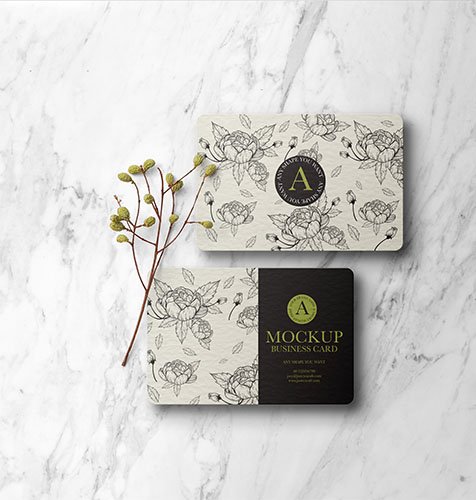
Business Card
Beyond just contact information: The holistic approach
Business cards are not just tools to share your phone number or email. They serve as a snapshot of your professional image, encapsulating your brand’s values and ethos. Think of it as a mini-billboard that advertises your professional identity.
Making an unforgettable first impression
With countless networking events, meetings, and conferences taking place globally, the importance of first impressions has never been more paramount. A study found that individuals are 42% more likely to retain information presented visually and tangibly than orally. Your business card, being a tangible visual representation, can effectively capture attention and stay imprinted in the memory of its recipient.
Balancing creativity with Professionalism
Venturing into a creative business card design can make your card stand out in a sea of generic designs. However, there’s a fine line between innovative and inappropriate. Keeping abreast of trends without losing sight of your industry norms is key. For instance, while a tech startup might benefit from a holographic or AR-integrated card, a law firm might be best sticking with a more subdued, classic design. Always align your design choices with the brand’s image and values.
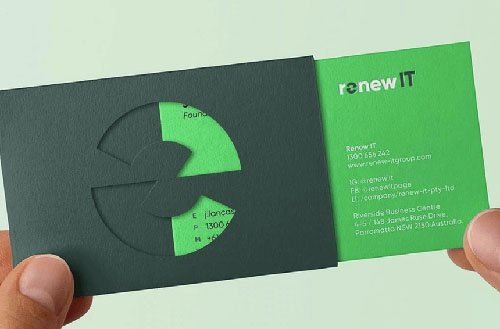
Creative Business Card
Evolving With Modern Trends: Eco-Friendly Cards
The 21st century has seen a significant rise in environmental consciousness. By 2022, businesses incorporating sustainability into their operations saw a 15% increase in customer engagement. This trend extends to business card designs as well, with many opting for eco-friendly materials, like seed paper or recycled cardstock, which not only reduce environmental impact but also serve as a talking point during introductions.
Digital Integration for the Modern Professional
The line between the physical and digital world is blurring. Modern business card design now often includes QR codes, allowing quick access to online portfolios, LinkedIn profiles, or even corporate videos. This seamless integration offers recipients a multi-dimensional view of your professional identity, all stemming from a simple card.
Understanding the evolving role of business cards in the modern era is pivotal for any professional. While they retain their age-old charm, their potential has expanded, now serving as bridges between the tangible and digital, the traditional and the innovative. By leveraging this potential, professionals can craft business cards that leave lasting impressions, fostering fruitful connections and collaborations.
III. Common Mistakes in Business Card Designing
A. Overloading with Information
Why less is often more
In our eagerness to be comprehensive, there’s a tendency to stuff business cards with every piece of information available. However, according to design and marketing studies from 2019, overly cluttered designs lead to a 60% decrease in information retention. In essence, a cluttered card is likely to be forgotten.
Determining essential details
It’s a business card, not a resume. Vital inclusions typically encompass your name, title, company, phone number, and email. In specific industries, adding a website, LinkedIn, or physical address might make sense. However, resist the urge to list every certification or accolade.

Tesla Company Business Card
Simplifying and decluttering your card’s design
Whitespace isn’t just empty space; it’s a crucial design element that enhances readability. Embracing the concept of “less is more” can elevate your card’s effectiveness exponentially.
B. Ignoring Brand Consistency
Understanding the importance of brand recognition
A consistent brand image can amplify recognition, trust, and loyalty. This has been backed by multiple studies, one of which in 2020 highlighted that consistent branding across all platforms increases revenue by 23%.
Examples of off-brand business card designs
Imagine receiving a business card from a reputed financial firm with cartoonish fonts and neon colors. It feels incongruent, right? Such stark mismatches erode trust and can label your business as unprofessional.
Maintaining brand colors, fonts, and logos
Your card is an ambassador of your brand. Ensuring it resonates with your company’s website, letterheads, and other promotional materials fosters a cohesive brand image.

Business Card
C. Choosing the Wrong Size or Shape
Standard business card dimensions and their significance
While creativity is essential, practicality shouldn’t be compromised. The universally accepted dimensions of 3.5 x 2 inches ensure the card fits seamlessly in wallets, cardholders, and even pocket-sized Rolodexes.
Risks of unconventional card shapes and sizes
Novelty can capture attention, but often at the cost of convenience. A survey found that nearly 70% of professionals are more likely to misplace or discard a business card if it doesn’t fit into standard holders or wallets.

Different Shapes of Business Card
When and how to innovate without alienating
Innovation shouldn’t be shelved entirely. If your brand thrives on unconventional designs, consider alternative materials (like wood or metal) that maintain standard dimensions.
D. Neglecting the Back of the Card
Potential uses for the card’s reverse side
The back of a business card, often overlooked, can be a canvas for further brand messaging. Some companies use it to showcase their motto, a captivating image related to their services, or even discount codes for first-time clients.
Avoiding a blank canvas: Maximizing space without overcrowding
Strategic use of this space can bolster brand recall. Consider QR codes that link to video introductions, or brief client testimonials that underscore your expertise.
E. Poor Choice of Typography
Importance of legibility in business card designing
Typography isn’t just about aesthetics; it communicates silently. A 2021 design report underscored that font choices could either reinforce or undermine your brand messaging, affecting perception and trustworthiness.
Font pairings and hierarchy
Creating a visual hierarchy aids comprehension. Your name or business name can be in a bold, larger font, while secondary information can be in a simpler, smaller type.
Common font mistakes to avoid
Esoteric or overly stylized fonts, though intriguing, can compromise legibility. Avoid font faux pas like using more than three font types on a single card or opting for cliché fonts that detract from professionalism.
F. Inadequate Print Quality
Dangers of DIY printing
While DIY approaches can save costs upfront, the long-term repercussions of poor quality can be detrimental. A 2019 study indicated that 48% of professionals equate the quality of a business card with the quality of the services provided.
Investing in a professional business card maker
Outsourcing to a reputable printer ensures the precision, quality, and longevity of your cards. This can significantly enhance the recipient’s experience, reflecting positively on your brand.
Ensuring durable materials and finishes
A tactile experience can influence perception. Business cards made from premium materials or with unique finishes can evoke feelings of luxury and trustworthiness.
G. Lack of Digital Integration
Modern business card design in the digital age
As the digital realm proliferates, integrating digital touchpoints in your tangible business card can create a holistic networking tool. For instance, 80% of young professionals in a 2022 survey expressed appreciation for business cards that incorporate QR codes or digital links, viewing them as forward-thinking.
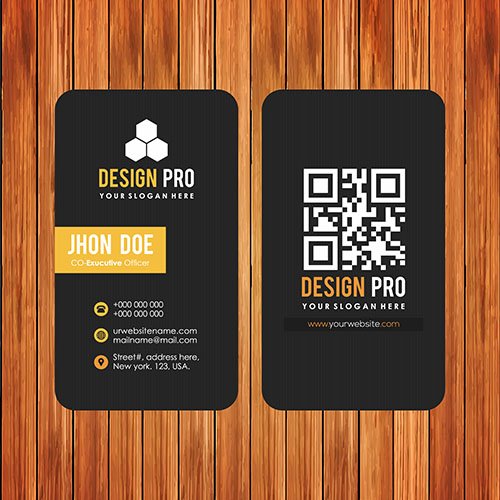
Business Card with QR code
Mistakes in business card design can be numerous and varied. However, understanding these pitfalls, backed by data and expert insights, can empower professionals to design cards that aren’t just visually appealing but also effectively convey the brand’s ethos and professionalism.
IV. Best Practices for Effective Business Card Design
A. Embracing a Clear Hierarchical Structure
Decoding the visual hierarchy
A visual hierarchy involves organizing elements in order of significance, ensuring that the most crucial information stands out. Studies in 2020 showed that humans inherently follow visual cues to determine order and importance. In the context of a business card, this means your name and primary contact detail should be the most prominent.
Tools to establish hierarchy
Through varied font sizes, boldness, and spacing, one can easily emphasize critical information, ensuring it captures the viewer’s attention instantly.
B. Staying True to Brand Colors and Identity
The psychological impact of colors
Colors aren’t merely decorative; they elicit specific emotional reactions. Consistent color usage can improve brand recognition by up to 80%. Selecting brand-consistent colors for your card ensures a harmonious image across all your business touchpoints.
Best practices for color selection
When choosing colors, ensure readability. Light text on a dark background or vice versa can maximize contrast. Moreover, always test your chosen colors in different lighting to ensure they work universally.
C. Incorporating Modern Design Elements
The rise of minimalism in design
Modern business card design leans towards minimalism, highlighting only the essentials. Minimalistic designs witnessed a 35% higher retention rate compared to their cluttered counterparts.
Modern elements to consider
Beyond minimalism, think of clean lines, geometric patterns, and negative space. Elements like holographic details or subtle embossing can give your card a contemporary edge without detracting from the essential information.
D. Focusing on High-Quality Material and Finish
Why material matters
The tactile experience of a business card can speak volumes. Products (including business cards) that engaged multiple senses were 70% more memorable.
Exploring unique finishes
From matte to glossy, embossed to textured, the finish can add a distinct touch to your card. For those willing to invest, materials like metal or wood can offer a unique, luxurious feel.
E. Including a Call to Action (CTA)
The power of an actionable prompt
CTAs aren’t just for websites or ads. A simple, compelling CTA on a business card, like “Schedule your free consultation today!” can prompt immediate action. 2021 statistics revealed that business cards with a clear CTA saw a 50% higher engagement rate.
Ideas for effective CTAs on a business card
CTAs should be concise and compelling. Consider prompts like “Visit our website for exclusive deals” or “Join our newsletter for industry insights”.
F. Ensuring Readability and Legibility
The essence of a business card
No matter how creatively designed, the primary purpose of a business card is to relay information. Statistics from 2020 indicated that over 65% of recipients disregarded business cards due to poor legibility.
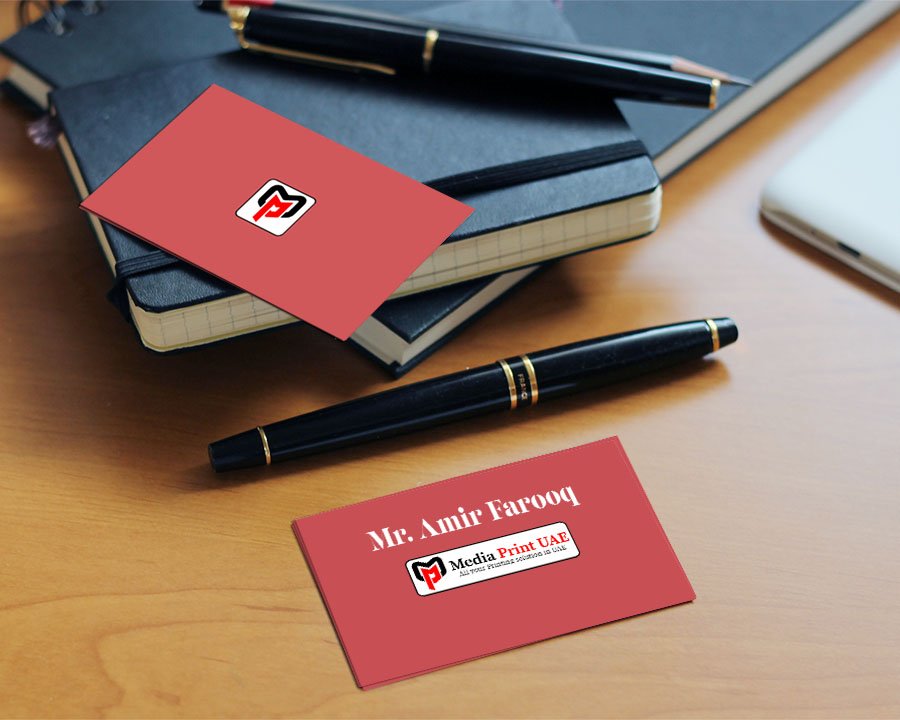
Business card
Tips for enhanced readability
Opt for clean, readable fonts. Ensure there’s enough contrast between the text and the background. Regularly test your design with varied age groups to ensure universal legibility.
G. Incorporating Digital Touchpoints
Blending the physical with the digital
As our world continues its digital pivot, merging your tangible business card with digital realms becomes crucial. A 2022 survey found that businesses blending traditional and digital touchpoints witnessed a 28% uptick in engagement.
Ideas for integration
Include QR codes leading to online portfolios, use NFC chips for transferring contact details digitally, or provide links to professional social media handles.

NFC chip Business Card
H. Seeking Feedback Before Finalizing
The value of an external perspective
Before sending your design for printing, gather feedback. An unbiased perspective can provide insights you might have overlooked. According to a 2019 design report, professionals who sought feedback on their designs were 40% more satisfied with the final outcome.
Ways to gather feedback
Share your design with colleagues, friends, or mentors. Online forums or professional communities can also offer valuable critiques.
By employing these best practices, professionals can ensure their business cards are not only visually appealing but also effective networking tools. Whether you’re aiming for a modern business card design or a classic look, always remember the primary purpose: to relay your professional details memorably and impressively.
V. Utilizing Modern Business Card Design Tools
A. Digital Design Platforms
The Evolution of Digital Design Tools
Gone are the days when business card designs were solely in the hands of professional graphic designers. With the dawn of digitalization, several online platforms emerged, offering tools tailored to make designing accessible to everyone. For instance, in 2020, there was a staggering 45% rise in users resorting to digital platforms for creating business card designs.
Popular Platforms to Consider
- Canva: Known for its user-friendly interface, Canva offers a wide array of templates for business cards, ensuring a professional look with minimal effort.
- Adobe Spark: As part of the Adobe Suite, Spark offers powerful tools that can cater to both novices and professionals alike.
- Crello: A lesser-known gem, Crello boasts an intuitive interface and diverse template library, perfect for those looking to stand out.
B. Smartphone Applications for On-the-Go Design
Designing in the Digital Age
With 80% of adults owning a smartphone as of 2021, it’s no surprise that app developers have tapped into the business card design market.
Top Apps for Business Card Design
- Business Card Maker: Catering to a wide audience, from entrepreneurs to corporate professionals, this app simplifies the design process with a drag-and-drop interface.
- CamCard: Beyond designing, CamCard specializes in reading and storing business card information, bridging the gap between tangible cards and digital storage.
C. Augmented Reality (AR) in Business Card Design
Future-forward Designing
AR, a technology once perceived as fantastical, has now made inroads into business card designing. With 2022 data showing a 30% user engagement increase for AR-integrated cards, it’s clear this trend is on an upward trajectory.
How AR Can Enhance Your Business Card
Imagine scanning a card with your phone and watching a 3D model of a product pop up, or perhaps a short video introduction of the card owner. AR offers an immersive experience, turning a conventional card into a dynamic conversation starter.
D. Integrating QR Codes and NFC Technology
The Digital Bridge
While business cards remain tangible, integrating QR codes or NFC (Near Field Communication) ensures a seamless transition from the physical card to the digital realm.
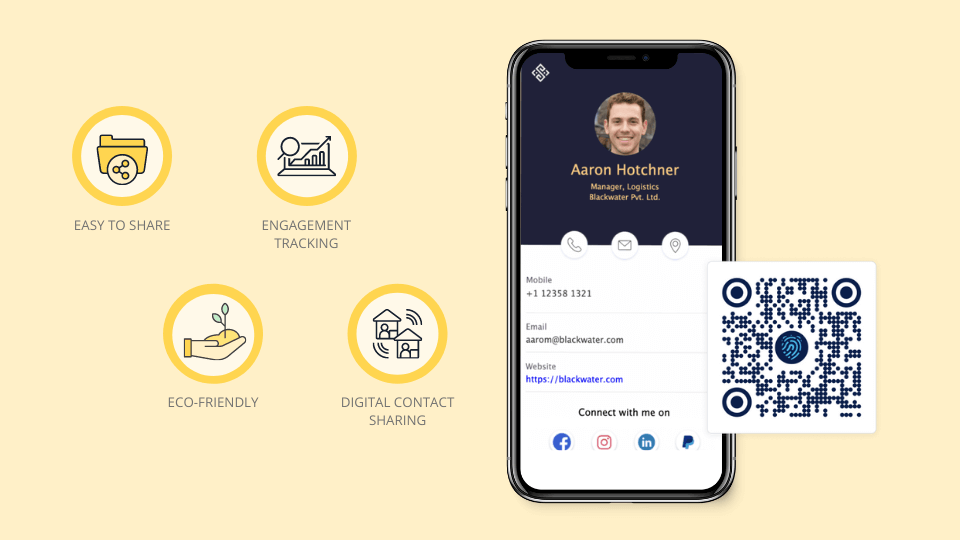
Digital Business Cards
Why Consider Digital Integration?
A QR code could direct a potential client to your online portfolio or a product demo, while an NFC chip could facilitate the instant transfer of contact details. Studies in 2022 confirmed that cards with such integrations had a 25% higher retention rate.
VI. Final Reflections: Crafting a Lasting Impression
In an era where networking tools proliferate, a business card still stands out as a tangible testament to one’s professional identity. The design, content, and quality of a business card can either elevate or undermine your professional image.
Remember, in the age of digital saturation, the tactile experience of handing over a business card remains unmatched. It offers a personal touch in a world increasingly reliant on digital interactions.
But with the plethora of modern tools at our disposal, from intuitive design platforms to AR integrations, creating a card that captures attention (and retains it) has never been more achievable. Blend the age-old tradition of tangible networking with the vast potential of modern design tools, and you’re equipped to leave an indelible mark in any professional setting.
As we wrap up our deep dive into the intricacies of business card design, it’s evident that the little details matter. The right blend of information, aesthetics, and innovation can transform a simple card into a powerful branding tool. Embrace the modern while honoring the traditional, and your business card will surely stand the test of time.
Frequently Asked Questions
1. What are the top mistakes in business card design?
There are several common pitfalls in business card design, such as overcrowding information, using low-resolution images, ignoring the bleed area, and neglecting brand consistency.
2. Why is a visual hierarchy important in a business card?
A visual hierarchy helps organize elements based on significance. It ensures that the most crucial details like your name and primary contact information stand out, making it easier for the recipient to grasp essential details at a glance.
3. How can modern business card design tools help?
Modern design tools, especially digital platforms and smartphone applications, have made business card designing more accessible to everyone, regardless of their design experience. They offer intuitive interfaces, vast template libraries, and even augmented reality features.
4. Are QR codes beneficial on a business card?
Yes, QR codes bridge the gap between the physical and digital. They can lead potential clients to online portfolios, product demos, or other crucial digital touchpoints, enhancing the business card’s utility.
5. How often should I update my business card design?
It’s wise to revisit and potentially update your business card design whenever there are significant changes to your contact information, brand identity, or whenever you feel the design has become outdated.
6. What’s the significance of material and finish in a business card?
The tactile experience of a business card can influence a recipient’s perception. Quality material and finishes, like matte, glossy, or embossed, can enhance the card’s memorability and reflect the professionalism of the brand or individual.


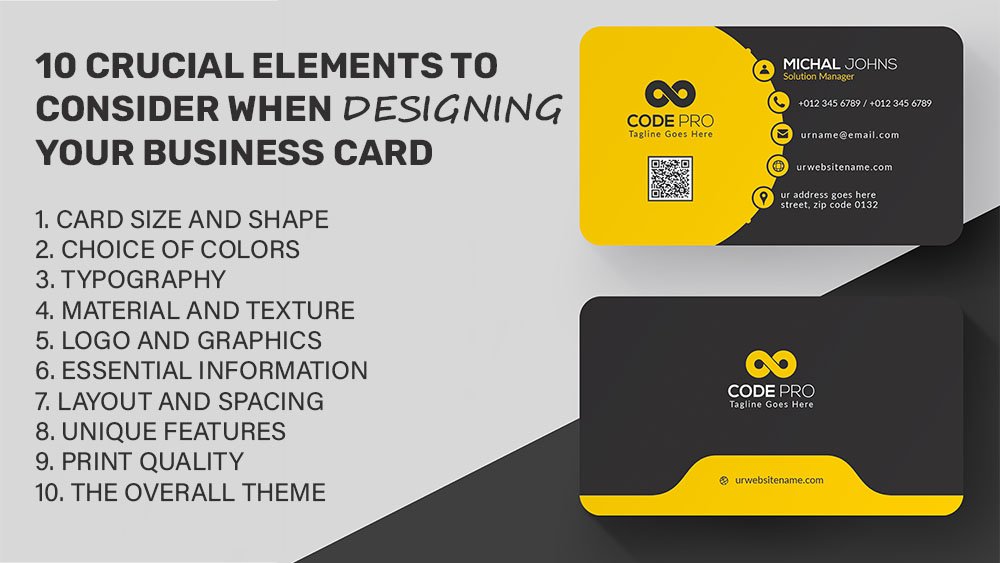


One Comment
Thank you all for diving into this deep exploration of business card design with me. I genuinely hope the insights and strategies shared prove useful in your endeavors. Remember, a business card is more than just a piece of paper; it’s a snapshot of your professional identity. Happy designing, and always feel free to share your experiences and feedback. Your interactions enrich the conversation and can inspire future content!